Kniphofia drepanophylla
Kniphofia drepanophylla Baker
Family: Asphodelaceae
Common names: sickle poker (Eng.); sekelblaar-vuurpyl (Afr.); umathunga (isiZulu)
Introduction
The sickle poker, with broad, strongly recurved leaves and yellow-green flowers, is one of the Vulnerable species of Kniphofia. It is now known from six to ten populations around the Pondoland area where it is under severe threat due to ongoing habitat degradation due to overgrazing, trampling and a deleterious fire regime. Its preferred habitat is marshy grassland. It is very similar to K. baurii and K. coddiana.
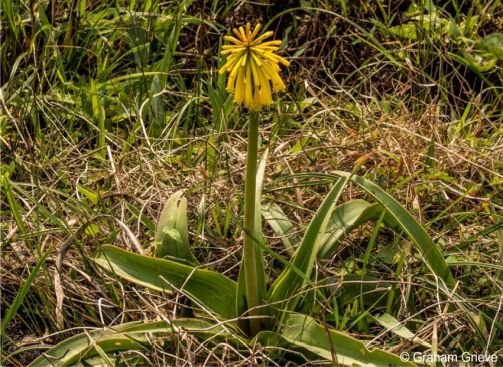
Description
Description
A herbaceous perennial plant with few- to several-stems that grows 250–600 mm in height, forming small groups. It has long recurved, drooping leaves 150–300 mm long when the plant is flowering but growing up to 600 mm in length and 15–40 mm in width. The flowers are borne on long, slender stalks that grow up to 600 mm in height, overtopping the leaves. The flowers are greenish yellow, often tinged with dull red and spreading in bud, lemon-yellow and pendulous when mature, 35–40 mm long, and are arranged in subglobose, apically lax, basally dense spikes, 50-70 mm long and 60 mm wide. The fruits are capsules that contain numerous seeds. Its flowering time is in late winter to spring, between August and October.
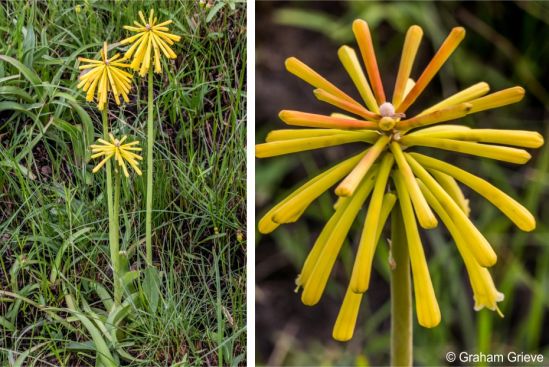
Conservation Status
Status
According to the Red List of South African Plants, the conservation status of this species is assessed as Vulnerable (VU). Kniphofia drepanophylla is experiencing ongoing habitat degradation caused by overgrazing, trampling and a deleterious fire regime.
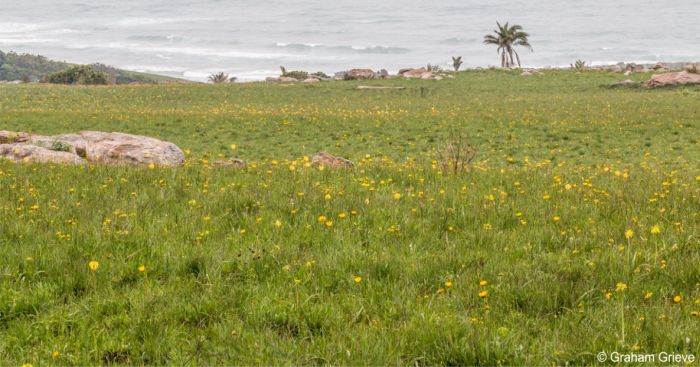
Distribution and habitat
Distribution description
Kniphofia drepanophylla is a South African endemic, restricted to Pondoland, between the Lupatana and Mtentu Rivers in the Eastern Cape. It is locally common inside the Mkambati Nature Reserve, where it is not impacted by heavy grazing. There are very few records of this species from outside the Mkambati Nature Reserve, which may suggest poor collection of this species in inaccessible tribal land outside the reserve. These areas are also extensively degraded by overgrazing and frequent fire, and wetland habitats are also particularly affected by trampling cattle. This species is more likely to be threatened in areas outside of the Mkambati Nature Reserve. The plant, originally found in marshy grasslands, moist grassland, swamps or wetlands, thrives in moist soil. A close similarity has been noted between K. drepanophylla and K. baurii, however, they also have some differences: K. drepanophylla tends to be smaller and its leaves are broader, more recurved, and more yellow-green, while K. baurii tends to have glaucous leaves. Records from Ngele Mountain in southern KwaZulu-Natal occur at a much higher altitude than specimens from the southern Pondoland coast, and are intermediate between K. drepanophylla and K. baurii.
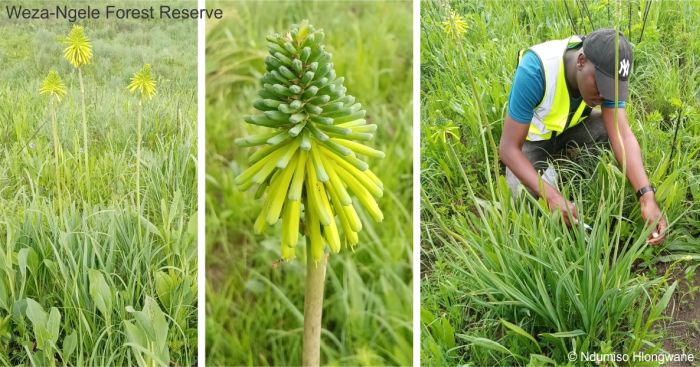
Derivation of name and historical aspects
History
The genus Kniphofia, which includes the plants commonly known as red hot poker, was named in honour of Johannes Hieronymus Kniphof, 1704-63, who was Professor of Medicine at Erfurt University, Germany. Kniphofia belongs to the family Asphodelaceae, which comprises 17 genera (10 of which occur in South Africa) and about 750 species. About 71 species of Kniphofia occur in Africa, and 48 of these are found in South Africa. For a genus that is so instantly recognisable in gardens, it may be surprising to find that Kniphofia have been grown regularly in cultivation for the last 150 years. Although Europeans first became aware of Kniphofia in the 17th century, soon after colonisation of the Cape of South Africa, it was not until the mid-19th century that the genus became a regular feature in gardens.
Kniphofia drepanophylla was first collected in 1887 and described in 1892. The species name drepanophylla is derived from Greek and means ‘with sickle-shaped leaves’.
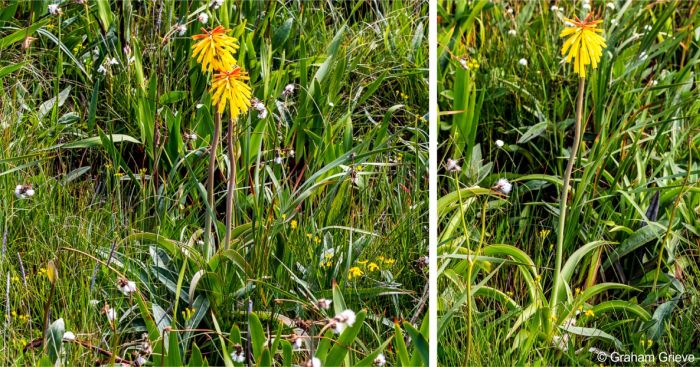
Ecology
Ecology
The flowers of this species attract pollinating insects such as bees and butterflies to the garden. They are also frequently visited by nectar-feeding birds such as sunbirds and sugarbirds.
Uses
Use
Kniphofia species have traditionally been used to treat a number of diseases. According to a recent study on ethnomedicinal uses, K. drepanophylla rhizomes are reported to have medicinal characteristics that can treat ringworm, wounds, pimples, acne and eczema, while the roots are used in the treatment of tuberculosis. It is believed to have anti-inflammatory, diuretic and antiseptic effects.
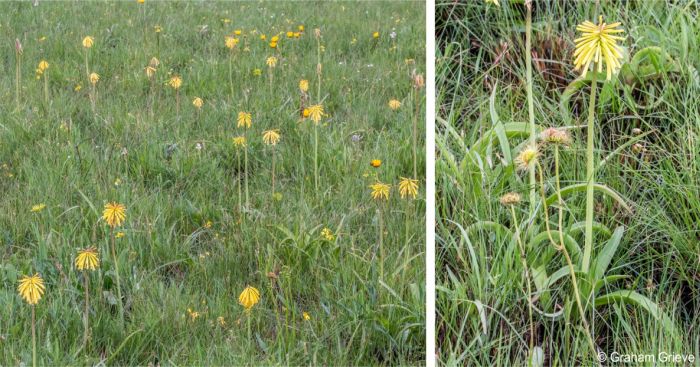
Growing Kniphofia drepanophylla
Grow
Grow Kniphofia drepanophylla in well-drained, rich soil located in an open, sunny position or in partial shade. This species requires plenty of water during the growing season (spring and summer) if they are to thrive and flower well. They should also be fertilised monthly during their active growing period for best performance. In its subtropical habitat, Kniphofia drepanophylla is evergreen, but it is frost hardy in South Africa, surviving freezing temperatures by dying down in winter and resprouting in spring. In very cold climates, it requires protection during winter. In cultivation, Kniphofia resent disturbance. Kniphofia drepanophylla is ideally suited to permanently or seasonally wet grassy areas, around ponds or water features, as well as rockeries, mixed beds and borders. Also suitable for containers.
Kniphofia drepanophylla can be propagated by division or seed. Large clumps can be divided and planted directly into the ground, although it is best to pot them and grow them on until they are well established. Seeds can be sown in spring, and they normally germinate in about 2 months. Once they have germinated, place the seedlings into their pots. Grow them on in the greenhouse for at least their first winter and plant them out into their permanent positions in late spring.
It grows best in moist, but well-drained soil; both loam and sandy soil are recommended mediums since they allow excess water to drain away, as poor drainage can be detrimental. The soils must be slightly acidic to neutral in pH, and they must receive full sun or partial shade. It is essential to plant Kniphofia drepanophylla in well-draining soil to prevent root rot and ensure healthy growth.
References
- Baijnath, H. 2004. Red (and yellow) hot pokers. The Conservatory 3: 24–28.
- Codd, L.E. 1968. The South African species of Kniphofia. Bothalia 9: 363–513.
- Diriba, T.F. and Deresa, E.M. 2022. Botanical description, ethnomedicinal uses, phytochemistry, and pharmacological activities of genus Kniphofia and Aloe: A review. Arabian Journal of Chemistry 15: 1–14.
- Eckel, P.M. 2010-2024. A Grammatical Dictionary of Botanical Latin. Missouri Botanical Garden. https://www.mobot.org/mobot/latindict/search.aspx.
- Grieve, G. 2017-Sep. Observation of Kniphofia drepanophylla, Mkambati Nature Reserve, Eastern Cape. iNaturalist. Online. https://www.inaturalist.org/observations/222651998.
- Grieve, G. 2019-Oct. Observation of Kniphofia drepanophylla, Lupatana, Eastern Cape. iNaturalist. Online. https://www.inaturalist.org/observations/138943733.
- Plants of the World Online. Kniphofia drepanophylla Baker. https://powo.science.kew.org/taxon/urn:lsid:ipni.org:names:537010-1. Accessed 19 Jun 25.
- Ramdhani, S. 2006. Evolutionary and biogeographic studies in the genus Kniphofia Moench (Asphodelaceae). Doctoral dissertation. Rhodes University, Grahamstown.
- Stern, M. 2002. Kniphofia Moench (Asphodelaceae). PlantZAfrica. Online. http://pza.sanbi.org/kniphofia-species.
- Von Staden, L. 2008. Kniphofia drepanophylla Baker. National Assessment: Red List of South African Plants. https://redlist.sanbi.org/species.php?species=2207-39.
- Whitehouse, C. 2016. Kniphofia the complete guide. Royal Horticultural Society: RHS Media. Peterbotough.
Credits
Ndumiso Hlongwane
Pretoria National Botanical Garden
June 2025
Acknowledgements: images of Kniphofia drepanophylla by Graham Grieve from his observations posted on iNaturalist.
Plant Attributes:
Plant Type: Bulb
SA Distribution: Eastern Cape
Soil type: Loam
Flowering season: Spring, Early Summer, Winter
PH: Acid
Flower colour: Red, Yellow
Aspect: Full Sun
Gardening skill: Easy
Special Features:
Horticultural zones








Rate this article
Article well written and informative
Rate this plant
Is this an interesting plant?
Login to add your Comment
Back to topNot registered yet? Click here to register.